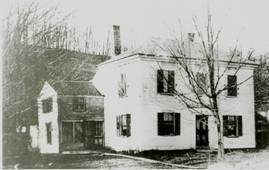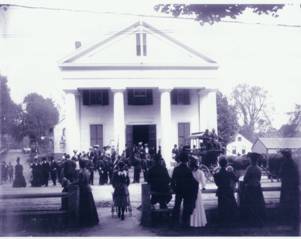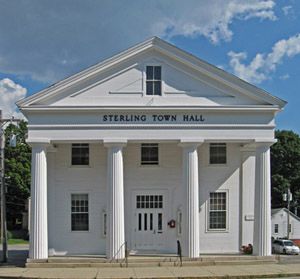1835 Town Hall History
The 1835 Sterling Town Hall...Then and Now
The 1835 Town Hall was built by a local Architect/Builder, John M. Springer, in 1834-1835 at a cost of $2857.85 (no small sum at the time) to replace the first Town Hall (seen at left). The first town hall was moved from the town center to its current location on Worcester Rd (just past Honey Farms on the right) where it was converted to a residence and is still in use today.

First Town Hall, built in 1800
Built in 1800, the first Town Hall had a meetinghouse on the first floor and a school room on the second. In 1835, that school room was replaced with a new brick schoolhouse on School Street.
The “new” 1835 Town Hall became the center of the community where it hosted over a hundred Town Meetings and probably hundreds of community functions as well a many town fairs, dances and theatrical performances in the upstairs auditorium. As you can see by the amount of money spent and the fact that it still stands tall after all these years, it was built with a lot of thought, pride and workmanship. No expense was spared on the architectural design, granite foundation, slate roof, large supporting timbers, interior woodwork, hardwood maple floors in the upstairs auditorium, the stage and balcony, and dual wooden staircases to the auditorium.

"New" 1835 Town Hall
It has been well maintained over the years, but has also undergone many changes. Obviously, there was no running water, electricity, sewer system or baseboard heating when it was built. All of these things have been added over the years without significant alterations to the building. During the 1970s, a major renovation took place to repair some structural problems, meet fire safety requirements, update bathrooms, replace the wooden staircase and install drop ceilings. At that time, the town offices were located in this building and continued to be there until the early 1990s.
In 1998 the Historical Commission completed a study of building and in 2001 the 1835 Town Hall Committee was formed by the town to plan and coordinate maintenance and facilitate the use of the building. It was a slow process since there was much work to be done. Temporary walls were removed from both the first and second floors, open meeting space was created, floors were repaired and carpeted, broken windows and window panes were repaired, roof repairs were done, unwanted articles where removed and auctioned, the building was furnished by recycling items from the school and library renovations, walls were patched and painted by a prison pre-release program, and floors were cleaned and waxed. This work was done with a small annual maintenance budget, a lot of elbow grease by committee members, community volunteers and numerous requests to the boy scouts. After a significant amount of work, the space was finally ready for use by any group or member of the community that needed it.
It is the goal and mission of the 1835 Town Hall Committee to continue to maintain and enhance the building while planning the restoration of original architectural details lost during previous renovations. Some of the original items are the wooden staircases, original ceilings on the both the first and second floors, and access to the second floor balcony. Universal accessibility to the second floor auditorium and stage is also priority as is the continued maintenance of the building.
In 2005 the town, aided by a grant from the state, commissioned an “Architectural/Structural Assessment and Feasibility Study for Universal Accessibility of the Sterling 1835 Town Hall”. The study found that the building was structurally sound, needed some immediate maintenance and provided a plan for accessibility. The immediate maintenance included roof repairs, furnace and chimney repairs, painting of the exterior, replacing storm windows, repairs to the exterior plaster on the portico, and reglazing of the window panes. This work has been completed with the exception of the reglazing and the painting of one side of the building. One of the reasons for the study was to determine the best way to provide universal accessibility to the second floor. The study suggested an addition to the side of the building to house an elevator. The plan is to complete the painting on the right side of the building once the addition is complete.
 Over the last few years, the building has provided a temporary home for a number of public services: EMS 2002-2003, Library 2003-2004, Fire Department 2004-2005 and most recently the DPW 2007-2008 while their facilities were being renovated. It is currently home to many of the town recreation programs, as well as the Veterans Office, community and nonprofit functions, and can be rented for private functions.
Over the last few years, the building has provided a temporary home for a number of public services: EMS 2002-2003, Library 2003-2004, Fire Department 2004-2005 and most recently the DPW 2007-2008 while their facilities were being renovated. It is currently home to many of the town recreation programs, as well as the Veterans Office, community and nonprofit functions, and can be rented for private functions.
It is used regularly by scouting groups, 4-H, town committees, guitar lessons, a children's music program and hosts various community clubs. Periodic events such as the Candidates Forum, cultural events, and informational presentations are also held here. To reserve the 1835 Town Hall for a group or meeting, contact Judy Janda at the town recreation department, (978) 422-3041. A donation is requested to help maintain the space.
To bring us to the “Now”, the 1835 Town Hall Committee is currently researching ways to obtain the funds needed for the accessibility renovations and building restorations while it continues to maintain and preserve the space for use by the community. We hope you'll stop by to visit this historic landmark and appreciate its grandeur and architectural details (don't forget to check out the auditorium. It has changed the least over the years and is a great space). The 1835 Town Hall is open most days and many evenings.

